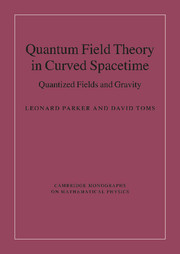Book contents
- Frontmatter
- Contents
- Preface
- Acknowledgments
- Conventions and notation
- 1 Quantum fields in Minkowski spacetime
- 2 Basics of quantum fields in curved spacetimes
- 3 Expectation values quadratic in fields
- 4 Particle creation by black holes
- 5 The one-loop effective action
- 6 The effective action: Non-gauge theories
- 7 The effective action: Gauge theories
- Appendix: Quantized Inflaton Perturbations
- References
- Index
3 - Expectation values quadratic in fields
Published online by Cambridge University Press: 25 January 2011
- Frontmatter
- Contents
- Preface
- Acknowledgments
- Conventions and notation
- 1 Quantum fields in Minkowski spacetime
- 2 Basics of quantum fields in curved spacetimes
- 3 Expectation values quadratic in fields
- 4 Particle creation by black holes
- 5 The one-loop effective action
- 6 The effective action: Non-gauge theories
- 7 The effective action: Gauge theories
- Appendix: Quantized Inflaton Perturbations
- References
- Index
Summary
Adiabatic subtraction and physical quantities
A number of quantities of physical interest, such as the action S and the energy-momentum tensor Tµν, are quadratic in the fields and their derivatives evaluated at a single point. As discussed in Chapter 1, the expectation values of such quantities diverge and can be regularized in the case of free fields in Minkowski spacetime by normal ordering. In curved spacetime, even for free fields, the implicit gravitational interaction introduces additional divergences. Furthermore, vacuum energy must be treated more carefully because it can give rise to gravitational effects through the gravitational field equations.
Various methods have been developed to regularize and renormalize quantities that involve squares or higher powers of fields or their derivatives evaluated at a single point of spacetime. Among them are proper-time regularization, dimensional regularization, zeta-function regularization, point-splitting regularization, particularly by the Hadamard method, and adiabatic regularization in homogeneous spacetimes. In this chapter we employ several of the above methods of regularization, including adiabatic, Hadamard, point-splitting, proper-time, and dimensional regularization as applied to curved spacetime. The trace anomaly of the energy-momentum tensor of the conformally coupled free field in a Robertson–Walker spacetime is derived using adiabatic regularization and compared with the equivalent result obtained from the proper-time series. It is shown that the expectation values of all the components of the energy-momentum tensor then follow from the trace anomaly by using the conformal symmetry of the spacetime.
- Type
- Chapter
- Information
- Quantum Field Theory in Curved SpacetimeQuantized Fields and Gravity, pp. 93 - 151Publisher: Cambridge University PressPrint publication year: 2009



